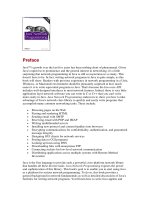twisted network programming essentials 2nd ed. - j. mckellar, a. fettig
Bạn đang xem bản rút gọn của tài liệu. Xem và tải ngay bản đầy đủ của tài liệu tại đây (2.45 MB, 232 trang )
Twisted Network
Programming Essentials
Jessica McKellar
Abe Fettig
Beijing • Cambridge • Farnham • Köln • Sebastopol • Tokyo
Special Upgrade Offer
If you purchased this ebook directly from oreilly.com, you have the following benefits:
▪ DRM-free ebooks—use your ebooks across devices without restrictions or limitations
▪ Multiple formats—use on your laptop, tablet, or phone
▪ Lifetime access, with free updates
▪ Dropbox syncing—your files, anywhere
If you purchased this ebook from another retailer, you can upgrade your ebook to take advant-
age of all these benefits for just $4.99. Click here to access your ebook upgrade.
Please note that upgrade offers are not available from sample content.
Foreword to the First Edition
“My name is Ozymandius, king of kings:
Look on my words, ye Mighty, and despair!”
Nothing beside remains. Round the decay
Of that colossal wreck, boundless and bare
The lone and level sands stretch far away.
—Percy Bysshe Shelly, “Ozymandius”
As the Twisted project’s originator and nominal leader—and as someone who is not being paid
for writing this—I can very honestly say that this is a fine book, and it has made me proud of
what I’ve started. You now hold in your hands a wondrous key that contains the knowledge to
unlock a very powerful software system—a software system borne of a consistent, methodical
vision; a vision half a decade in realization and hundreds of man-years in implementation; a
vision for a video game that has yet to be written, called “Divunal.”
I have been lauded many times for my role in Twisted’s creation, and in this foreword I will
attempt to disabuse you of the notion that any of it was on purpose. Not only was it an acci-
dent, but neither I, nor anyone else, has made one iota of progress towards my original goal of
writing a game.
When I was eight years old, I decided I wanted to be a writer. I was going to write video games
just like my favorite ones, the text-based games from Infocom. They were like books, but bet-
ter. I knew how to write already—at a fourth-grade level, or so I’m told—and all I needed to
figure out was the part where the computer wrote back. Lucky for you nobody thought to tell
me how hard that step between the input and the output was, or Twisted would be a series of
detective novels instead of a Python program.
Tolkien said it best: “The tale grew in the telling,” and I’ll say it worse: the code grew in the
hacking. Twisted began over a decade after my aforementioned first plunge into the nether-
world of software, as a solitary attempt to create a networking subsystem for a small online
fantasy world. Since then, it has become an ongoing community quest to unify all manner of
asynchronous communications. This book will take you on an adventure through Twisted for
the Web, Twisted for email, Twisted for chat, and of course, Twisted for whatever new kind
of networked application you want to dream up—maybe even an online video game.
Much as the tale of Twisted has grown and changed, its origins still have a profound effect on
its nature, and on its future. Having origins in an eclectic
[1]
problem domain has attracted an
eclectic
[2]
audience. The community in the online support forum engages in discussions that
are “often funny.” To put it more directly: we’re weird.
“Weird” is a badge I have long worn with pride, dear reader, so please take it as a compliment
that I bestow it upon you. You’re not simply non-average, you’re better than average. Almost
by definition, Twisted hackers are the ones for whom “good enough” isn’t good enough. You
are the web programmers who can’t use their operating system’s stock HTTP daemon because
you need more power and more control over how it’s run; the chat developers who aren’t con-
tent with chatting on a perfectly working network just because it doesn’t support some cool
new features you want; the (dare I say it?) gamers who aren’t content with the market’s offer-
ings of online games. You want to create something newer, different, better. To build higher
than those who have come before, because you are building not merely upon the shoulders of
giants, but upon the apex of an acrobatic balancing act of giants, or more literally an interlock-
ing network of frameworks and libraries for different tasks, rather than just one at a time.
Twisted will let you do that, by letting you leverage code written by far more and far better
programmers than I. Twisted provides a common method for that code to cooperate, which
means you can use all of that code without performing a complex integration pass. In this
spirit, I’d like to invite you to release your Twisted-based projects, or the infrastructure com-
ponents of them, as open source software, so that we might together build a Twisted commons
upon which many more fantastic applications will be built.
Don’t mistake this friendly vision for altruism, however. I didn’t have anything to do with the
start of the Free Software or Open Source movements, respectively, but they came along at a
convenient time for me. This feeling of share-and-share-alike has been a feature of the Twis-
ted community since day one, but not because I care about sharing.
[3]
It is because—I may
have mentioned this—I want to write a video game one day. A game that effortlessly connects
to the Web and to your email, that politely requests that you play when you have time, and
that reminds you to get back to work when you do not.
You see, the majority of Twisted’s core developers, including myself, suffer from Attention
Deficit Disorder. This malady is the grease that makes the magic wheels of integration turn.
While most developers—sane developers—would be content to write a perfectly good web
server that could work only as a web server and leave it at that, we are always afraid we’ll
suddenly lose interest and need a chat application instead—or maybe it should be a mail serv-
er? Hey, there’s a squirrel! I don’t like this song.
What was I saying? Oh yes. The essence of Twisted is apparently paradoxical. Created on a
whim by crazed eccentrics, designed to be a toy, and yet powerful enough to drive massive
email systems, high-traffic web sites, transaction-processing systems, and inventory manage-
ment applications.
However, the paradox is an illusion. People produce the best work when they are working
and having fun at the same time. It takes a sense of humor to call yourself a crazed eccentric
(whether it’s true or not). You have to have a sense of fun to try and build a toy. In enjoying
ourselves, we have brought to life a system that many of us have tried and been unable to cre-
ate in more serious surroundings.
So, when I look out upon the “lone and level sands” of Divunal, a game whose incarnation
today is little more than its name, I am not concerned. I am having a good time with Twisted.
With this book in hand, I have no doubt that you will, too.
—Matthew “the Glyph” Lefkowitz
CTO at Divmod, Inc.
(not a game company)
(yet)
August 2005
[1]
And difficult! Making an online game work properly is hard.
[2]
And intelligent! People who solve unusual problems are always learning.
[3]
Caution for the humorless: this is a joke. I am not actually an enemy of freedom. Still, there is some
truth to this.
Preface
This book is about Twisted, an open source, event-driven networking engine written in
Python.
Twisted supports many common transport and application layer protocols, including TCP,
UDP, SSL/TLS, HTTP, IMAP, SSH, IRC, and FTP. Like the language in which it is written,
it is “batteries-included”; Twisted comes with client and server implementations for all of its
protocols, as well as utilities that make it easy to configure and deploy production-grade Twis-
ted applications from the command line.
Twisted includes both high- and low-level tools for building performant, cross-platform ap-
plications. You can deploy a web or mail server with just a few lines of code, or you can write
your own protocol from scratch. At every level, Twisted provides a tested, RFC-conforming,
extensible API that makes it possible to rapidly develop powerful network software.
In keeping with the spirit of the O’Reilly Essentials series, this book is not about torturing
you with the nitty-gritty details of specific networking protocols, or with exhaustively docu-
menting Twisted’s APIs. For a comprehensive treatment of how to use Twisted to build ap-
plications for a particular protocol, please get your footing with this book and then consult the
official documentation.
Instead, the goal of this book is to give you fluency in the primitives Twisted provides and
the idioms that it uses to build network clients and servers. It starts with an introduction to the
underlying event-driven model and a big-picture view of Twisted as a framework, focusing on
simple, self-contained examples that you can play with and extend as you explore Twisted’s
APIs. Where possible, the client and server examples are written so they can be run together.
After reading this book, you will have the tools and conceptual background to build any event-
driven client or server application you need, not just for the protocols that are a part of Twisted
and covered in this book, but also for new protocols that you build using Twisted’s primitives.
Why Use Twisted?
Why should you use Twisted instead of some other networking library or framework? Here
are a few compelling reasons. Twisted is:
Python-powered
Twisted is written in Python, a powerful, object-oriented, interpreted language. Python is
a language that inspires great enthusiasm among its fans, and for good reason. It’s a joy
to program in Python, which is easy to write, easy to read, and easy to run. And because
Python is cross-platform, you can run the same Twisted application on Linux, Windows,
Unix, and Mac OS X.
Asynchronous and event-based
Synchronous network libraries leave developers with a painful choice: either allow the ap-
plication to become unresponsive during network operations, or introduce the additional
complexity of threading. Twisted’s event-based, asynchronous framework makes it pos-
sible to write applications that stay responsive while processing events from multiple net-
work connections, without using threads.
Full-featured
Twisted includes an amazing amount of functionality. Mail, web, news, chat, DNS, SSH,
Telnet, RPC, database access, and more—it’s all there, ready for you to use.
Flexible and extensible
Twisted provides high-level classes to let you get started quickly. But you’ll never find
yourself limited by the way things work out of the box. If you need advanced functionality,
or if you need to customize the way a protocol works, you can. You can also write your
own protocol implementation, to control every byte sent over the wire.
Open source
Twisted is free, both as in beer and as in freedom. It includes full source code and is re-
leased under a liberal license. Want to distribute all or part of Twisted with your applica-
tion? You’re welcome to do so, with no obligations to release your own code or pay any
licensing fees. Want to get a better understanding of how an object in Twisted works? Take
a look at the source. And when you get to the point where you’re developing your own
improvements and extensions to Twisted, you can contribute them to the community for
the benefit of others.
Community-backed
Twisted has an active community of developers and users. If you run into a problem, you’ll
find many fellow developers ready to help on one of the Twisted mailing lists (see Finding
Answers to Your Questions, in Chapter 1). Or you can drop into the #twisted IRC channel,
where the chances are good you’ll be able to start a live conversation with the very person
who wrote the code you’re having trouble with.
An integration-friendly platform
A Twisted application can share data between several different services within the same
process. This makes integration tasks a snap. You can write an SMTP-to-XMLRPC proxy,
an SSH server that lets you update a website, or a web discussion board that includes an
NNTP interface. If you need to transfer data between systems that don’t speak the same
protocol, Twisted will make your job a whole lot easier.
What This Book Covers
This book does not attempt to exhaustively document every module and class available for the
Twisted framework. Instead, it focuses on presenting practical examples of the most common
tasks that developers building network applications face. This book will also help you to un-
derstand the key concepts and design patterns used in Twisted applications.
This book has three parts:
Learning Twisted basics through building basic clients and servers
This part covers installing Twisted, an architectural overview of the framework, and build-
ing basic TCP clients and servers. We then apply the primitives and idioms from the
chapters on basic applications to a variety of client and server examples for a particular
protocol, HTTP.
Building production-grade servers
At this point, well-practiced with basic clients and servers, we focus on deploying these
applications in a robust and standardized fashion using the Twisted application infrastruc-









![the gun digest book of firearms assembly, disassembly [pt. v - shotguns] 2nd ed. - j. wood (dbi, 2002) [ecv] ww](https://media.store123doc.com/images/document/14/y/xf/medium_xfe1399285242.jpg)